Fri 2 Oct 2020
MIKE NEVINS on HBO’s Perry Mason and Two (2) Cool & Lam Novels.
Posted by Steve under Authors , Columns , Reviews[6] Comments
by Francis M. Nevins
I had already decided that the subject of this column would be Erle Stanley Gardner when I learned about the new incarnation of Perry Mason in an 8-part mini-series on HBO. I don’t have cable or satellite but from conversations with a few friends who do, plus the write-up in the New York Times and in the June/July issue of the AARP magazine, I get the distinct impression that poor old ESG is whirling in his grave.

It’s the early 1930s and Mason (Matthew Rhys) is a World War I veteran, an alcoholic, and suffering from what we now call PTSD. He’s not (or at least not yet) a lawyer but a sleazy private eye working for and studying law under an established criminal attorney. In effect he’s morphed into a squalid avatar of Paul Drake. When his mentor dies just before he’s to try a big murder case, Mason completes his apprenticeship, sits for and passes the bar, and takes over the defense.
Sound crazy? But the premise does touch base with Gardner more than you might think. ESG never went to law school but apprenticed himself until he felt he was ready to take the bar. The new Mason’s mentor (John Lithgow) is named E.B. Jonathan, which is precisely the name of the crusty and ethically challenged lawyer who served as mentor to Pete Wennick in a short-lived series Gardner wrote for Black Mask in the late Thirties.
The portrait of Mason’s city seems to come straight out of the city, modeled on Poisonville in Hammett’s RED HARVEST, where Ken Corning practiced in another of Gardner’s Black Mask series: crooked cops, corrupt pols, the whole nine yards. Perhaps I’ll catch up with this version of Mason someday.
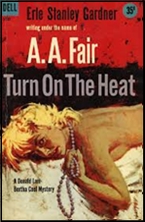
Gardner and I go back a long way. I discovered him in my teens, and over the generations I’ve read all of the Mason novels, some of them three or four times, and most of the A.A. Fairs, very few of them more than once. Not re-reading the exploits of Bertha Cool and Donald Lam, at least the early ones, may have been a mistake. Last year I discussed THE BIGGER THEY COME (1939), with which the long-running series kicked off, and THE KNIFE SLIPPED, which was probably also written in 1939 but didn’t get published until just a few years ago.
In TURN ON THE HEAT (1940), which until recently was considered second in the series, we learn what we would have learned from THE KNIFE SLIPPED had it not been rejected 80-odd years ago: that Donald was not just suspended for a year from the California bar for dreaming up a legal way to commit murder, as he’d told Bertha in THE BIGGER THEY COME, but permanently kicked out of the profession.
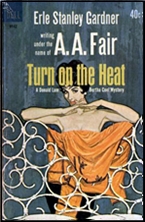
In any event he’s working for Cool as a PI but not yet her partner when the firm is hired by a man calling himself Smith. The job is to locate a young doctor’s wife who, after the failure of her marriage, had vanished almost twenty years earlier (meaning soon after the end of World War I) from the then thriving small town of Oakview, several hours’ drive from LA.
The young doctor had also vanished, apparently along with his attractive nurse, but Smith insists he has no interest in either of them. Donald drives to Oakview to research public records and the back files of the local newspaper, where he learns from the editor’s niece, a bright young lady desperate to leave the now dying town, that he’s the third person to be hunting for information on the vanished couple.
At the end of his first day on the job he’s given a black eye and run out of town by a tough guy who might be a cop. Undeterred, Donald soon learns that the elusive doctor has changed his name and set up practice in thriving Santa Carlotta, which is much closer to LA and seems to be Gardner’s name for Santa Barbara. A few days later a telegram from the Oakview editor’s niece tells him that the doctor’s wife has come back and, posing as a reporter for the paper, he revisits the town to interview the now middle-aged woman.
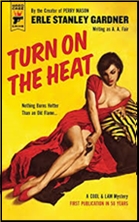
Another lead takes him to the second of his two predecessors on the trail of the doctor’s wife. Soon he reaches the core of the mystery: the doctor is now running for mayor of Santa Carlotta and the corrupt politicos in office are trying to create a scandal around him. Eventually there’s a murder, and it seems that, like so many characters in Perry Mason novels, both the medico and the ambitious newspaper gal discovered the body and kept mum about it. As Mason would have done but without benefit of legal gimmicks, Donald sets out to clear the innocent.
Considering the family resemblances between Gardner and Fair novels, it’s amazing that it took years before the two authors were recognized as one. As in so many Mason cases, a few questions remain unanswered at the end of GOLD COMES IN BRICKS. How did the bent cop Harbet learn of Donald’s involvement so quickly? Why was the photograph of a character who never appears in the book removed from the dead woman’s apartment? But Gardner keeps things moving at warp speed, creates a network of deceptions within deceptions (including a couple of scenes where Donald scams Bertha), and even offers a dollop of fair-play detection. If you wonder why some readers prefer the C&Ls over the Perry Masons, read this novel.
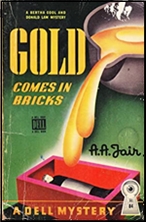
GOLD COMES IN BRICKS (1940) resembles the earlier C&Ls in that the murder is a relatively trivial event buried under a mountain of scams. Passing himself off as, of all things, a physical fitness instructor, Donald enters the household of prosperous businessman Henry Ashbury, who’s hired the firm to investigate a pair of $10,000 checks to cash recently signed by his daughter Alta, and quickly learns that her father’s suspicions are on the mark: she’s been paying gambler Jed Ringold to get back some stolen love letters written to her by a married man about to go on trial for the murder of his wife—letters which the man’s sleazy defense attorney is desperate not to let fall into the hands of the prosecution.
All hell breaks loose when Ringold is shot to death in his hotel room a few minutes after being given a third check by Alta. Donald, spying on the situation from the room next door, takes the check out of Ringold’s pocket before slipping away. For a few chapters his maneuvers to protect himself and Alta and confuse the witnesses who saw him on the scene take a back seat as he heads for northern California to look into a scheme to sell stock in a gold-dredging venture and, with the help of a tough old prospector who might be a Gardner self-portrait, launches a plot to scam the scammers.
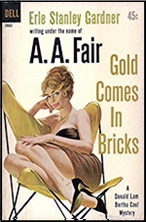
The frantic pace and abundant insights into securities fraud and gold-claim salting hold our attention despite having little to do with the murder. Donald falls in love as usual but this time does not get beaten up. As customary in these early outings, it’s his show all the way. Bertha curses and grouses about money but doesn’t contribute a great deal. So much for the claim that the C&Ls are variations on what Rex Stout had initiated five years before THE BIGGER THEY COME. Perhaps Donald is a bit like Archie Goodwin (although he could never take orders or narrate as engagingly as Archie does), but at the thought of Bertha as another Nero Wolfe, the mind turns cartwheels.
October 2nd, 2020 at 8:09 pm
Much as I love the Mason novels, the early ones particularly, count me among those who prefer Cool and Lam. Donald is indeed no Archie Goodwin, but he is a congenial figure to spend an evening with and it is always fun keeping up with him.
October 2nd, 2020 at 10:38 pm
Keep up with Donald Lam? I never could. And that’s what makes him so much fun to read about.
October 3rd, 2020 at 12:57 am
I always felt Gardner enjoyed writing Donald and Bertha more than he did Perry in some sense. I don’t mean he disliked writing the Mason books (as some writers come to feel about popular characters), in fact I would say his continued interest shows far into both series, but I always felt like he was more relaxed, and a little closer to his looser pulp style in the Lam and Cool series.
Gardner always liked the underdog, and Perry, though his clients fit, was far from an underdog in any sense — in fact in most books the whole power of the state hardly seemed adequate to stand up to Perry Mason.
Donald is the ultimate underdog, his brain the only thing between him and disaster in most of his adventures. I can’t help but think that was closer to Gardner’s heart however much he loved writing old friends like Perry and Della.
October 3rd, 2020 at 3:32 am
For a while the first episode of the new miniseries was available on YouTube (maybe still is). Watched it.
Best features: decent storytelling that holds one’s interest.
Terrific performance by talented Matthew Rhys. He works overtime to make this dubious material interesting. Admittedly, his character is remote from the beloved novels.
Worst feature: grim violence that is in horrible bad taste. You have been warned! This should have been resisted at all costs.
Medium feature. The characterization of DElla Street is not bad. And rather closer to the novels than the treatment of Perry.
PS Everyone should see the half-hour 1950’s pilot for “Cool & Lam”. Directed by the talented Jacques Tourneur.
IMHO Ken Corning is a dry run for Perry Mason.
Pete Wennick anticipates Donald Lam.
October 4th, 2020 at 6:53 pm
The Knife Slipped is particularly interesting for its treatment of Bertha Cool. She was all over the book — telling Donald what to do and how to do it, complaining when he went over budget, or withheld information from her. It was enough to convince me that the door was rejected because Bertha was too emasculating. In the subsequent books Bertha takes a backseat. I think Gardner was told to tone her down.
October 4th, 2020 at 7:36 pm
I’ve been trying to get to that book ever since it came out. I really really have to now.